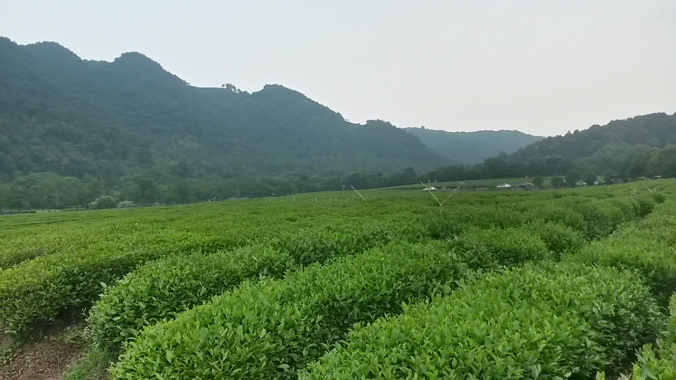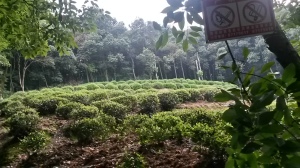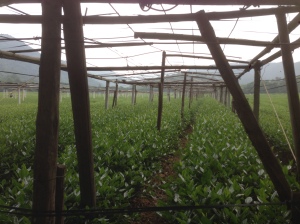Plantation Vs Wild

This is an example of a plantation. See how the trees are lines, similar to corn fields. In the back grounds you can see the sprinkler system they use to properly water these plants. Further in the background you see that we are somewhat in the mountains, definitely the lower altitudes.
Some of the most famous teas come from plantations. The thing about plantations is that they are controlled. Most of the time there is a ceiling, meaning that the trees are allowed to grow to a certain height and then are cut down. This makes for easy picking, either by machine or man. Japan is a great example of plantation style growing. A lot of the farms in Japan are plantation with heavy use of machinery. This leads to high productions costs, but that is another topic.
I’m not saying that plantation tea is bad, I’m just want to emphasize that it is a controlled process for growing tea. The green tea on the Hangzhou plantation was probably the best green tea that I tasted in China. I think what plantation producers are really trying to do is create a uniform flavor for their tea.
Wild trees are just that wild tea growing trees. There are a few protected wild trees and growing areas in China. Some actually have armed soldiers protecting the area. These trees range in age, some range from 500 – 800 years. The oldest protected tree is about 2000 years old. The biggest factor with these styles of tea growing areas is the randomization of flavor over the years. I think this is what makes this area so much fun. Being able to taste different areas of China through tea is an interesting practice.
Shaded vs Sun

Along with being on the mountain some of the tea plants are naturally shaded by surrounding trees. Someone literally cut out a square and planted these trees. The surrounding trees offer more shade, compared to the more open plantations.
Tea producing trees that are somewhat shaded are producing some high quality teas. The shade increases the quality of the leaves. The chemistry behind it is this: “shade increases chlorophyll production in the plants by reducing natural photosynthesis in the leaves.” This increases the quality and flavor of the trees in that area. You will see a lot of mountain teas out there. A simple reasoning behind this is that direct sun is only on tea plants for so long, as the sun will be on the other side of the mountain for half the day. On some plantations you may see other older trees that are providing shade to the smaller tea plants. On more industrial plantation you may actually see sort of roof covering the tea leaves.

I’m not completely sure what these were used for. I can imagine that they would be able to through a tarp or form of covering over these plants. Maybe when it is too sunny out.
Tea produced in direct sun may not always be of the best quality. The leaves have a higher risk of burning. In regards to green tea, most of the good stuff is single origin and not blended. So you are going to taste the burnt leaves easier. Blending or mixing in puer is more common, so you may actually see some more direct sun growing areas. Sencha is actually known for being grown in full sunlight.
The sun exposure actually increase the catechins (EGCG) in the leaves producing green tea. For more chemistry and knowledge on this subject, I will have to catch up with my food science and chemistry friends.
This brings this section to a close! Check out the next section, Brewing Green Tea + Storage!
Pingback: Determining Quality Green Tea Part I | MurphCha